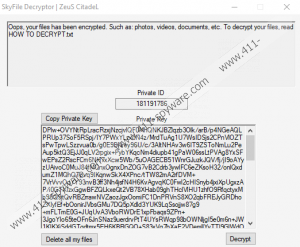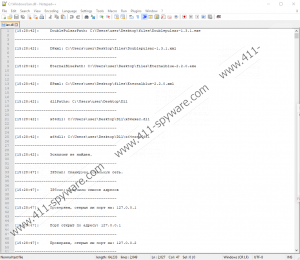Skyfile Ransomware Removal Guide
Skyfile Ransomware is a malicious application that encrypts user’s files and appends .sky extension at the end of their titles. No doubt, in exchange for a decryption tool the malware’s creators would want to receive a payment. The only problem is no one can guarantee these people will hold on to their end of the deal even if you pay the ransom. Thus, we would advise the infection’s victims to consider this option very carefully. If you decide you do not want to gamble with your savings, you should get rid of Skyfile Ransomware with no hesitation. The instructions located below can help you with this task as they will list all necessary steps needed to remove the malware manually. Keep it in mind if you have any copies of data that was encrypted you can replace locked files with them as soon as the system is secure again.
Our specialists are not sure if this is the file version of Skyfile Ransomware; meaning, the malware might still be in the development stage. Nonetheless, if it is already being distributed, we think it could be spread via infected email attachments or unsecured RDP connections. This is why to keep your system protected from such threats it would be advisable to stay away from suspicious Spam emails or any other emails originating from unknown sources. Moreover, to lessen the chances the system could be attacked while exploiting its vulnerabilities, researchers recommend not to keep any outdated programs. The same goes for your operating system as it should always be up to date too. Additionally, we should mention users are advised to watch out for malicious web pages and to acquire a reliable security tool.
Once, Skyfile Ransomware settles in it should check whether the user has any antivirus tools installed. At the moment of writing, the sample we tested did not do anything, but if it gets updated, it may attempt to delete the security tool or disable it. It might create lots of files on the Windows and other directories, although after the encryption process some of them are erased automatically. During the encryption, the malicious application should lock user’s documents, pictures, photos, and other personal files. Instead of renaming them the threat is supposed to append a specific extension, e.g., sunrise.jpg.sky. Later on, the infection should delete the shadow copies and so make it impossible to recover files via system backup. Afterward, Skyfile Ransomware should show a window saying all personal files were locked and asking to read a text document called HOW TO DECRYPT.txt. Inside of it, users might find instructions on how to pay a ransom. Of course, as said earlier we do not recommend doing because there are no guarantees any of your files will get decrypted. Instead of putting up with the malicious application's developers demands we would advise erasing the malware and restore the data you can from copies on cloud storage, removable media devices, etc.
To eliminate Skyfile Ransomware manually, you would need to remove all data created by it. To make it easier for you to find such files, our specialists have prepared the recommended deletion instructions located a bit below this text. Needless to say, if the task appears to be a bit too difficult, you should not hesitate to acquire a reliable security tool and set it to scan your system.
Get rid of Skyfile Ransomware
- Tap Ctrl+Alt+Delete.
- Select Task Manager.
- Locate a particular process belonging to the malware.
- Mark it and press End Task.
- Exit Task Manager.
- Press Win+E.
- Locate the given directories:
%TEMP%
%USERPROFILE%\Desktop
%USERPROFILE%\Downloads - Find a malicious file downloaded before the malware appeared.
- Right-click the doubtful file and select Delete.
- Then find this location C:\Windows
- Look for following files:
debuglog.dll
lan.dll
{random numbers}ID
0F8BFBFF000506E3
0F8BFBFF000506E3files - Right-click these files one by one and select Delete.
- Locate the ransom note.
- Right-click it and press Delete.
- Exit File Explorer.
- Press Win+R.
- Type regedit and press Enter.
- Navigate to HKCU\Software\Microsoft\Windows\CurrentVersion\Run
- Look for a value name called Java Platform Auto Updater.
- Right-click it and press Delete.
- Empty your Recycle Bin.
- Reboot the system.
Skyfile Ransomware Screenshots:


Skyfile Ransomware technical info for manual removal:
Files Modified/Created on the system:
| # | File Name | File Size (Bytes) | File Hash |
|---|---|---|---|
| 1 | SkyFile Decryptor.lnk | 1055 bytes | MD5: 3314791c3e81818f64bd6304f530eb58 |
| 2 | 738f961b84c02d46dc93f45f65034fa28475ba89a2fd44deede40d2e669020ba.exe | 312320 bytes | MD5: 047a6de8ee4137cf6b6c856723bd2019 |
| 3 | SkyFile Decryptor.exe | 38912 bytes | MD5: 35af6c81780ef86a78ae05139510435c |
Memory Processes Created:
| # | Process Name | Process Filename | Main module size |
|---|---|---|---|
| 1 | 738f961b84c02d46dc93f45f65034fa28475ba89a2fd44deede40d2e669020ba.exe | 738f961b84c02d46dc93f45f65034fa28475ba89a2fd44deede40d2e669020ba.exe | 312320 bytes |
| 2 | SkyFile Decryptor.exe | SkyFile Decryptor.exe | 38912 bytes |

